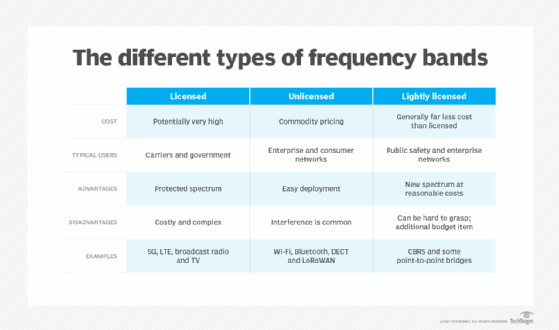What are licensed and unlicensed wireless frequency bands?
Licensed frequency bands are reliable and offer better performance than unlicensed frequency bands, which are low cost and easy to deploy but interference is common.
We are surrounded by wireless technologies more so now than ever before. Some wireless technologies come to mind more easily because we tend to use them at a personal level, like Wi-Fi and cellular networks. But the concept of wireless encompasses an incredibly far-ranging landscape, from Bluetooth and broadcast technologies to military radars and satellite communications -- each landing in its own slice, or slices, of wireless spectrum, often referred to as bands. Although the terms spectrum and bands are often used interchangeably, a band starts and stops at discrete frequencies, whereas spectrum is a more generic term for the entire range of radio frequency signals.
In the United States, the Federal Communications Commission (FCC) sets rules that govern the use of radio spectrum and wireless bands, and similar agencies exist around the world. The general regulatory construct for bands is they are either licensed or unlicensed, but we're starting to see nuance to that delineation. It's worth considering some of the differences between licensed vs. unlicensed frequency ranges and how the frequency management landscape is evolving.
What are licensed bands?
Licensed bands ensure consistent performance and reduce interference concerns because individual companies or users pay a licensing fee for exclusive transmitting rights within the licensed band. With limited licenses that are carefully coordinated based on location, a given band stays well managed from the spectrum perspective, giving a radio wave its best chance to succeed. To understand licensed bands further, let's go back to simpler times.
When broadcast radio and TV were new, specific bands were allotted for all stations to use. Within those bands, individual stations applied for licenses. What specific frequency channels they were allowed to use within a band were part of their license agreements, along with power output and geographic areas of allowed coverage.
The license framework was, and still is, designed to make sure a broadcast band FM radio station on 88.3 MHz has plenty of space between itself and any other stations on the same frequency, for example. Furthermore, no other technologies are allowed to use this licensed space, thus ensuring a fairly coordinated radio frequency landscape across the licensed bands.
Cellular networks are more modern examples of technology that rely on licensed bands, and there are also licensed line-of-sight, point-to-point bridge systems, where two wireless endpoints can be joined together to form a link in spectrum that is uncluttered thanks to licensing. Bridges using the 80 GHz band are just one example.
Benefits of licensed frequency bands
Licensed bands offer major advantages for the technologies in use:
- Reliability. Because there isn't spectral contention in a given location, issues like interference are generally nonexistent -- provided everyone follows the rules.
- Performance. Each frequency is typically dedicated for a specific use, and systems can generally perform at their best as long as they are well maintained.
- Protection. If another entity tries to use radio equipment in the same band without authorization, legal remedies -- in the form of FCC enforcement and other actions -- are available.
Licensed bands enable users to take advantage of lower noise levels and a controlled environment where competition is limited.
Disadvantages of licensed frequency bands
There is no free lunch when it comes to technology, and every paradigm is a series of tradeoffs. In the case of licensed frequencies, the benefits are balanced by the following disadvantages:
- Fees. Any licensed service has high costs of licensure compared to unlicensed frequencies.
- Bureaucracy. Licensed applications can be complicated with lengthy approval processes.
- Coveted frequencies aren't always "safe." On occasion, licensed frequencies come under threat from other technologies that petition the FCC for the right to use specific bands at the possible detriment of incumbent licensees.
What are unlicensed bands?
When comparing licensed and unlicensed frequency bands, unlicensed bands don't have the same rigid requirements that licensed bands do. At the same time, it's not quite a free-for-all. The FCC still defines maximum power levels allowed and other constraints that guide even the unlicensed bands. Organizations like the Wi-Fi Alliance and Bluetooth Special Interest Group help educate end users on benefits and proper use of common unlicensed frequencies.
One popular unlicensed band is the 2.4 GHz industrial, scientific and medical band. Here, you find Wi-Fi networks, Bluetooth, drone control signals, wireless microphones and hundreds of other technologies. Each one has the potential to make life miserable for the others to a certain degree through cochannel interference, but there are often -- but not always -- ways to carefully design these services so they can operate and coexist successfully.
Any product that will use an unlicensed band still needs to be type-approved by the FCC. This is how the manufacturer shows that a given product follows the rules. Consumers can then buy those products without being required to get their own individual licenses.

Benefits of unlicensed bands
Unlicensed bands have a wide range of benefits, including the following:
- Low-cost access. Aside from the purchase price of equipment, the frequencies are free for anyone to use, provided users follow existing constraints limiting power levels and other operations.
- Fast product development. These bands give innovators and other entrepreneurs the opportunity to introduce new services and technologies more quickly than if they had to apply for permission to use licensed spectrum, which has become increasingly scarce.
Disadvantages of unlicensed frequency bands
Despite being easy to use, unlicensed frequencies have their own challenges, including the following:
- Contention. Reliability can be hard to guarantee when several technologies need to coexist in the same bands. Interference is common.
- Lack of recourse. To make use of the unlicensed bands, device makers and end users need to accept that everyone has equal rights to the spectrum. If my garage door opener knocks out your VoIP call on Wi-Fi, there's not much that can be done except to try to reach an agreement on how not to disrupt each other.
- Somewhat wild device market. There is no clean delineation from the enterprise wireless space versus consumer-friendly wireless devices. Consumer devices aren't always carefully regulated for conformance to the FCC's rules or built for use beyond home networks. When consumer devices are brought to work, they can cause havoc for business wireless systems in the same frequency bands.
Lightly licensed bands on the rise
Even as the FCC attempts to creatively reallocate what technologies are allowed in which band, regulators and industry alike are realizing there are only so many frequencies that can be used. Because of the endless thirst for more spectrum, we're seeing more use of so-called lightly licensed bands, such as 3.5 GHz, used by the new Citizens Broadband Radio Service (CBRS) systems.
These bands rely on internet-based databases to control what discrete channel a given component can use -- based on what other channels in that band that may be in use by other CBRS systems or from higher-priority users in the same space, such as military radar systems and satellite communications. This model is becoming a popular FCC-prescribed way to ensure coexistence with other users of the same bands, while opening those bands somewhat for new users. Implementation of these frequency control mechanisms can be slow and technically challenging.
Editor's note: This article was updated to provide a more comprehensive look at licensed and unlicensed frequency bands, particularly their disadvantages.
Lee Badman is a network architect specializing in wireless and cloud technologies for a large private university. He's also an author and frequent presenter at industry events.








